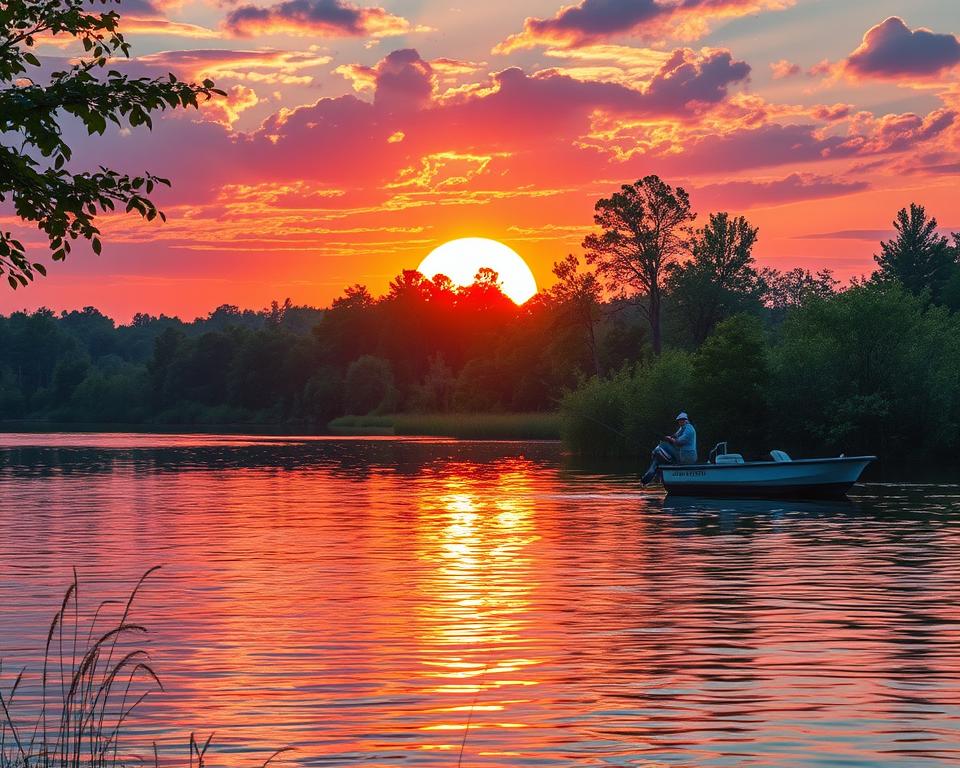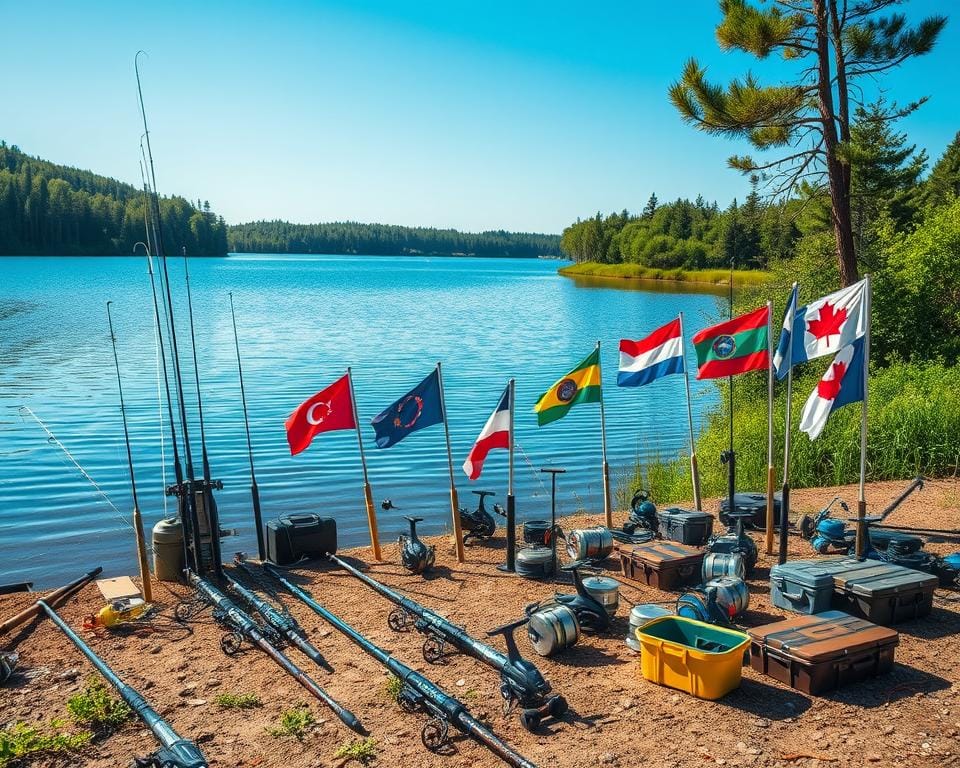Fishing is a popular hobby across the U.S. But, you must know the state fishing laws before you start. Each state has its angling regulations to protect fish numbers and keep the waterways healthy for the future. These rules include having the right U.S. fishing licenses and fishing permits by state. This keeps you out of trouble and helps the environment.
It’s important to keep up with rule changes. For example, California shut down the Klamath River Fall Chinook fishing because there aren’t enough salmon. However, steelhead and brown trout fishing is still allowed there. The new rules will be in the 2024-2025 Fishing Regulations Supplement by July 1, 2024. Fishermen should check the Klamath and Trinity River Information Hotline to stay informed.
In West Virginia, if you’re 15 or older, you need a fishing license. You also need a special stamp if you’re fishing for trout. These state fishing laws help keep fish numbers healthy. They set limits on how many fish you can keep and ban certain fishing gear, like nets and spears.
Rules change a lot depending on where you’re fishing. In places like West Virginia, there are special rules to protect certain fish and keep the ecosystem healthy.
By sticking to these angling regulations and getting the right fishing licenses, you help make fishing fun and sustainable for everyone. Enjoy your fishing adventures!
Understanding Fishing Regulations: The Basics
Fishing regulations can seem tough at first. But, they’re here for good reasons. They help look after fish populations and make sure fishing is enjoyable for everyone. Rules on fishing seasons, catch limits, and the need for licenses are key for protecting our water life.
Why Fishing Regulations Matter
Fishing rules are vital for keeping fish and their homes safe. Take, for example, California stopping some salmon fishing. Such actions show the importance of these rules for the environment. By following them, we help at-risk fish survive and balance sport fishing with commercial needs.
Types of Fishing Regulations
We see different kinds of fishing rules, each with a unique role:
- Fishing season rules: They decide when fishing is okay, protecting fish when they’re reproducing.
- Catch limits: These are the caps on how many fish you can catch, preventing overfishing.
- License requirements: In the U.S., you need a fishing license by a certain age, differing by state. Utah lets those under 12 fish for free. Licenses can sometimes work in nearby states, but there’s no single license for the whole country.
- Special permits: Required for certain fishing types, like in saltwater or ice fishing, addressing specific risks.
How Regulations Are Enforced
Enforcement of fishing laws uses various approaches:
- Angling law enforcement: Officers check on fishers, look at catches, and fine rule breakers.
- Public education: States, such as Utah, offer detailed fishing guides and online tips to help fishers stick to rules.
- Community involvement: Tools like email updates and blogs keep fishers in the loop, promoting rule following.
Getting to know fishing laws helps us fish responsibly and take care of our waters. By doing so, we ensure a healthy and productive environment for fish and people who love fishing.
Western States: Fishing Rules and Permits
Fishing in the Western States is thrilling but comes with certain rules. It’s important to know about the regulations and required permits. Let’s look at the rules in California and Utah for a lawful fishing trip.
California
The California Fish and Game Commission sets rules regarding fishing closures. This includes restrictions for the Fall Chinook in the Klamath and Central Valley rivers. These rules help conserve fish populations and get updated annually, with news expected by July.

California’s recreational fishing is a big industry, supporting about 25,000 jobs. It generates $3.0 billion in sales. Anglers go on roughly 5.2 million saltwater fishing trips each year, boosting the economy. Keep up with the latest rules from the Pacific Fishery Management Council and NOAA Fisheries to fish responsibly.
They require permits for fishing specific species in federal waters. This includes high-migratory species and Pacific halibut on the West Coast.
Utah
Utah provides detailed angling guidebooks with state-specific laws. These books give updates and interactive maps for legal fishing. They are key for anglers to comply with Utah’s regulations.
The Utah Fishing Guidebook is crucial for understanding current rules. Available online, it offers guidance for lawful and sustainable fishing. It’s a must-have for every angler in Utah.
Permits are crucial for fishing in Utah as well. Knowing about permit requirements helps avoid legal troubles. It also supports state conservation efforts.
Before fishing in the Western U.S., especially California or Utah, check the guidebooks. You will need permits for certain species like Pacific halibut. NOAA Fisheries has updated policies to promote sustainable fishing.
Get your permits through reliable sources like the Commercial Fishing Permits Center. They help with licenses and permits, ensuring an easy application process.
Learn more about fishing regulationsand permits on the official website
Midwestern States: Keeping Up with Fishing Policies
Fishing in the Midwest is more than just a hobby; it’s a heritage that combines natural beauty with plenty of fish. To fish smoothly, it’s important to know the rules and have the right license. The Midwest Fisheries Center, opened in 2013, helps manage water life and support fishing. Now, let’s look at the rules for fishing in Ohio and Illinois.
Ohio
In Ohio, fishing is a varied adventure, from Lake Erie to local lakes and rivers. Anyone over 16 needs a fishing license. You can buy these online, at approved places, or some shops. With 200 million fishing trips in the U.S. in 2020, Ohio’s spots offer great chances to fish, for both new and expert anglers. Ohio also works to keep fishing sustainable for the future.
Illinois
Fishing seasons in Illinois change by fish type and living places. This setup helps protect fish while they spawn. So, you can fish all year for certain kinds. Illinois has a detailed guide for anglers that lists rules, including catch limits, size rules, and closed seasons. With efforts like the Great Lakes Restoration and the National Fish Habitat Plan, Illinois aims to keep its waters healthy.
Following Midwestern fishing rules is key to conserving fish and nature. By following these rules, anglers help keep this activity sustainable. They also enjoy its economic and fun sides. Events like the Youth Outdoor Fest in La Crosse, Wisconsin, teach young people to fish responsibly.
Eastern States: Navigating Fishing Regulations by State
Fishing in the Eastern U.S. is a unique experience for any angler. It’s important to know the rules in Connecticut and nearby states. Following these rules makes fishing enjoyable and helps the fish thrive.
Connecticut
In Connecticut, the Connecticut Fisheries Division manages fishing rules and the health of water life. It’s key for anglers in the Eastern U.S. to stay current with these regulations. Click here for the latest fishing updates.

For striped bass, the rule is one fish per person each day, sized between 28” and 31”. This ensures fishing stays sustainable. Tautog rules change with the season, with sizes starting at 16″. In spring and late summer/fall, you can keep three fish a day. From October 15 to December 31, this increases to five fish.
Trout in Connecticut are catch and release to protect their numbers. You can keep three bluefish per day, with no size limit. If fishing from a for-hire boat, the limit goes up to five. Scup rules are changing in 2024 to cut recreational catches by 10%. These changes will likely include a size increase to 11” and changes to how many you can keep and when.
Summer flounder sizes might rise to between 18.5” and 19” to reduce catches by 28%. However, black sea bass rules should stay the same. This includes a 16.5” minimum size and specific rules for different times of the year.
For freshwater fishing, Connecticut has special times when trout and salmon fishing is paused. This helps the fish populations recover. The Connecticut Fisheries Division offers detailed information and tools like FishBrain to help anglers. These resources are great for fishing within the law and protecting the waterways.
| Fish Species | Regulation | Limit |
|---|---|---|
| Striped Bass | 1 fish/person/day, 28″-31″ | Unchanged |
| Tautog | 16″ minimum size | 3-5 fish/person/day |
| Bluefish | No minimum size | 3-5 fish/person/day |
| Scup | 10.5″-11″ proposed | Under review |
| Summer Flounder | Proposed: 18.5″-19″ | Season expansion |
| Black Sea Bass | 16.5″ minimum size | 2-6 fish/person/day |
Knowing these rules is key to fishing responsibly and successfully. The Connecticut Fisheries Division updates its policies often. This helps balance angler needs with protecting the water and fish. Connecticut is thus a top spot for fishing in the Eastern U.S.
Southern States: Fishing Guidelines You Should Know
The Southern States have unique fishing rules to protect marine life and support fishing. These rules include seasons and permits. It’s important for those who love fishing to understand these guidelines in Southern waters.
Florida
Florida’s fishing scene is vibrant, and its rules aim for sustainability. For selling certain fish, open access commercial permits are needed. These fish include Atlantic Dolphin/Wahoo and Spiny Lobster. Charter/Headboat permits are required in federal waters for fishing species like Snapper-Grouper.
Florida asks anglers to respect seasonal fish closures for the environment. Black Grouper and Gag have closures from January 1 to April 30. Red Grouper’s closure times depend on the area. This approach helps keep Florida’s fish populations healthy. Check out Florida’s fishing regulations.
Texas
In Texas, fishing permits aim for a healthy marine life. For trading specific fish, you’ll need Gulf and South Atlantic Dealer Permits. There are also targeted permits for smoothhound sharks, focusing on catch limits and gear.
Businesses in Texas need special permits for certain fishes. These include South Atlantic Rock Shrimp and Golden Crab permits. Smoothhound shark keepers must follow strict rules to keep fish populations stable. This makes fishing fair during the Southern fishing seasons.
| Permit Type | Required For |
|---|---|
| Gulf and South Atlantic Dealer Permits | Trading specific fish caught from federal waters |
| Swordfish – Atlantic Permit | Selling swordfish in federal waters |
| South Atlantic Rock Shrimp Permit | Fishing and selling South Atlantic rock shrimp |
| South Atlantic Snapper-Grouper Permit | Fishing and selling snapper-grouper species |
Conclusion
Learning about fishing regulations is key for both fun and responsible fishing. This guide highlights the rules from California to Florida. It helps anglers, whether they fish for fun or work, keep up with the local laws. These laws are important for protecting fish and keeping their numbers healthy.
Looking ahead, 2024 will keep the same rules for freshwater fishing, but 2025 will bring new rules for sport fishing. The FishBrain app partnership provides easy access to these rules for free. Anglers can also share their thoughts on these upcoming changes until May 31, 2024. This way, everyone can help shape the fishing rules to better suit the needs of the community and the environment.
Beyond just rules about licenses and fish sizes, there’s a lot more to discover. For example, there are programs for record-breaking fish and efforts to deal with harmful invasive species. In 2020, people went on 200 million fishing trips and caught 1 billion fish, showing how popular and valuable fishing is. Free Fishing Days let everyone, new or experienced, enjoy fishing without the cost of a license. This encourages people to try fishing, join in community events, and learn about fishing responsibly. By following fishing laws, we all help protect our waterways, ensuring fish are there for generations to come.

